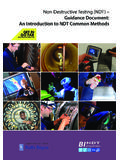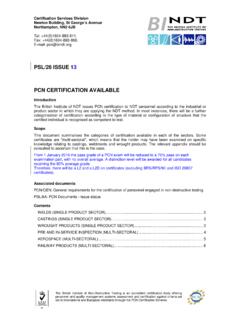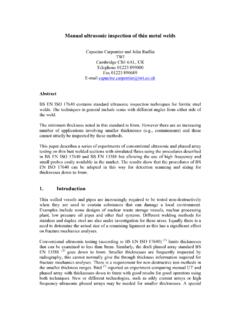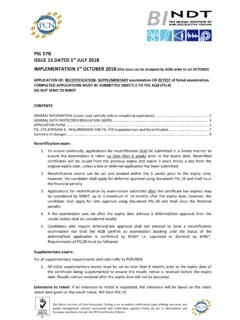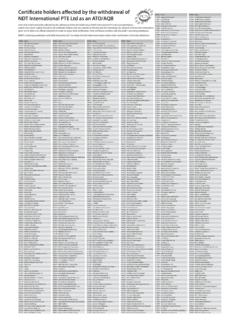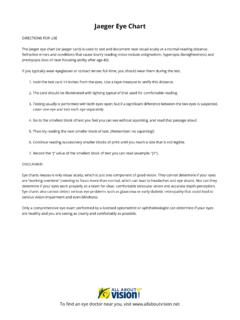Transcription of Non-Destructive Testing (NDT)
1 Non-Destructive Testing (NDT) Guidance Document: An Introduction to NDT Common MethodsSupported by lead employerNon- destructive Testing (NDT) Guidance Document: An Introduction to NDT Common Methods1 Contents1. Introduction ..22. Visual Testing ..3 Visual Testing is the most widely used method of Non-Destructive Testing (NDT). Even the more sophisticated methods require a visual test to be performed. In other methods, such as magnetic particle Testing , after a component has been magnetised, the operator performs a visual inspection to look for indications. Large sections of industry tend to take visual Testing for granted and pay little attention to Ultrasonic Testing .
2 10 Ultrasonic Testing is a versatile NDT method. Many techniques have been developed to allow full volumetric inspection of a large range of components made from a wide variety of materials. It is probably the most important method used in industry, certainly in the Radiographic Testing ..23 Radiography was one of the earliest NDT methods but, due in some way to health and safety implications, alternative methods are replacing it, for some applications, in industry. However, radiography remains one of the two main volumetric NDT Eddy Current Testing ..30 Eddy current Testing is a sophisticated method of NDT in which shallow swirling electric eddy currents are introduced into a component, allowing the detection of surface and slightly sub-surface Magnetic Particle Testing .
3 36 Magnetic particle Testing is a relatively simple NDT technique that can be used in the detection of surface and slight sub-surface discontinuities in magnetic Penetrant Testing ..46 Penetrant Testing is a simple NDT method used to locate surface-breaking discontinuities in metals and many non-metals using a penetrating Infrared and infrared Testing is a relative newcomer to the world of NDT. It involves monitoring the temperature variations of objects in the infrared portion of the electromagnetic Other Methods and Competencies ..58 There are other NDT methods and competencies listed in this section. Further details of these methods and competencies can be obtained from the British Institute of Testing (NDT) Guidance Document: An Introduction to NDT Common Methods2 Section 1 IntroductionNon- destructive Testing (NDT) is a mechanism used by engineers to detect defects in materials and structures, either during manufacturing or while in service.
4 Typically, the methods used are ultrasonics, radiography, magnetic particle, eddy current, dye penetrant and visual methods. This important and growing industry is involved in applying these proven techniques and procedures to the full range of engineering structures. When NDT is deployed to best effect as part of the complete engineering design process, it ensures the safe, reliable and long-lasting integrity of structures, such as power stations, aircraft, oil & gas installations and other safety-critical plant. Every day, more than 25,000 inspections are carried out in factories and on-site in the UK to detect defects and damage in a huge range of products, plant and structures; it is estimated that there are more than 120,000 inspectors operating worldwide.
5 The NDT community has formal mechanisms for skills development from Engineering Technicians through Chartered Engineer to Doctorate level. The global NDT industry had an estimated turnover in 2012 of about $ bn (about bn). This levers a much greater benefit to end-users through intelligent and reduced risk management. Regulatory bodies demand that NDT is used to demonstrate compliance with safety and other legislation and, for unregulated industries, the commercial advantages of reduced warranty claims, improved plant reliability and higher customer satisfaction justify its use. NDT inspection personnel are required to be fully competent, trained and certificated in accordance with national and international document has been provided as guidance for apprentices and other new entrants to our Robert A Smith, President of the British Institute of Non-Destructive Testing 2015-2016 Professor Robert A SmithNon- destructive Testing (NDT) Guidance Document: An Introduction to NDT Common Methods3 Section 2 Visual and Optical TestingVisual Testing is the most widely used method of Non-Destructive Testing (NDT ).
6 Even the more sophisticated methods require a visual test to be performed. In other methods, such as magnetic particle Testing , after a component has been magnetised, the operator performs a visual inspection to look for indications. Large sections of industry tend to take visual Testing for granted and pay little attention to Description of the Basic principles Visual and optical Testing is a method of NDT used to examine the surface condition of a component. Visual Testing is widely used by industry for just about every conceivable surface condition, from looking for processing or in-service discontinuities, to seeing if fruit is ripe and ready to eat.
7 Without realising it, we will all do some sort of visual inspection every day. By its very nature, visual and optical Testing can be simple and straightforward. At its simplest, a clean component can be inspected by an operator in adequate light with no equipment it can be that easy. Often, the operator will need to use optical equipment to aid the inspection, which can range from a hand-held magnifier to a flexible fibrescope or remote video systems. You may think that an unaided visual test would not be able to find small discontinuities, but this is not necessarily true. An experienced operator, under optimum conditions, may be able to detect even small tight cracks.
8 Repeatability is, however, a problem. If conditions are not optimised, the same operator may miss the same crack on the same component on a repeat inspection. This is why optical aids are often used to give the operator the best chance of finding the fault condition as often as possible. We have mentioned optimum conditions for visual inspection but what are these optimum conditions? Environment Inspection must take place in a clean, comfortable environment with adequate lighting. Attention should be paid to safety, working position and atmospheric conditions. Inspection requires considerable concentration by the operator so, as an example, if the working environment is very hot and noisy, this will affect the operator s ability to concentrate on the job and discontinuities can easily be missed in this way.
9 Lighting is very important and can greatly affect the results. Natural daylight is the best type of light to perform visual inspection in because, as a biological system, we have evolved with the sun as a principal light source. A cloudy day is the optimum as this provides diffuse illumination. Bright sunlight can lead to glare from reflective surfaces and this, in turn, could lead to discontinuities being missed. Artificial light can also be used for visual inspection; the operator must make sure that the correct light level stated in the specification or procedure is used. This light level is called illuminance, which is defined as the luminous flux per unit area falling on a surface.
10 It is measured in lux, one lux being the illuminance of a surface one metre from a light source of one candela. Luminous flux is the energy emitted per second from a light source. The unit of luminous flux is the lumen and the luminous flux emitted per unit solid angle is luminous intensity. A practical unit of luminous intensity is the candela. Most specifications will quote a minimum illuminance level that must be used, with figures between 500-1000 lux being common in many specifications. As a guide, to attain 500 lux at a test surface, a 100 W bulb at a distance of 460 mm, or a 75 W bulb at a distance of 380 mm, will be sufficient for Component preparation The component should be clean and free from protective coatings, for example dirt or paint, which can obscure the surface conditions being sought.

